By Emily Hall
“Cere-what?!” This is usually the response I get when people ask why my cat Sophie walks funny, and I tell them she has cerebellar hypoplasia. Though it is definitely a mouthful, cerebellar hypoplasia (CH) is not as complicated as it sounds. In fact, you may have already heard of it before! It is commonly referred to as “Wobbly Cat Syndrome.”
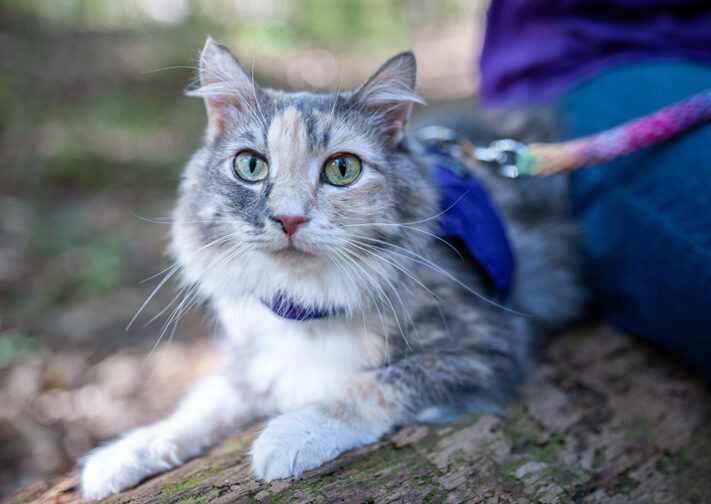
So… what is it?! I’m glad you asked…
1. Cerebellar hypoplasia is a neurological disorder.
Cerebellar hypoplasia (CH) is a disorder in which the cerebellum doesn’t develop completely before birth. The cerebellum is responsible for motor control and coordination, so having an underdeveloped cerebellum results in jerky movements, clumsiness, and sometimes even tremors. Though there are varying degrees of severity from mild to severe, a cat (or dog) affected by CH is generally wobbly, unsteady, and will often fall over when walking.
Cats with mild cases of CH may be a little unsteady on their feet or might possibly have slight head tremors, but they can generally get around with no major issues. Those with more severe CH usually can’t walk on their own and need help with things like eating and using the litter box. Then there are those with more moderate cases who fall somewhere in between.
My cat Sophie has a mild-moderate case. She can walk, but it looks like she’s had a little too much to drink, if you know what I mean. She stumbles and falls over, and her path might zigzag around instead of following a straight line. She CAN jump, but she doesn’t always hit her target. She instead chooses to climb most of the time (seriously, she must have the upper body strength of Arnold Schwarzenegger). She can use the litter box without assistance, but we do have to use litter boxes with high sides so she can lean against them when she’s going to the bathroom.
2. Cats with cerebellar hypoplasia are born that way.
CH is not something that can be contracted or developed later in life. It is a congenital condition, meaning affected animals are born with it. They don’t know any differently.
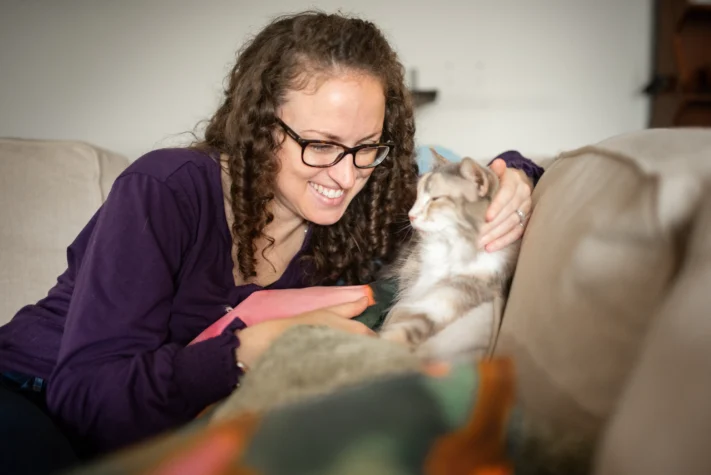
3. Cerebellar hypoplasia is most commonly caused by a preventable virus.
CH can be caused by a few different things, such as malnutrition, poisoning, or trauma while in utero; however, the most common cause is the feline panleukopenia virus, which can be prevented with vaccinations. If a mother cat contracts panleukopenia while pregnant, the kittens may develop CH before birth. The condition may affect only one kitten, or the entire litter may be affected, sometimes to varying degrees.
4. There is no cure for cerebellar hypoplasia.
Though there is no treatment or cure for CH, a cat can learn to compensate for the condition and therefore seemingly improve. Many CH cats can’t jump, so they instead develop excellent climbing skills. Encouraging play can also help to build up muscle strength in their legs, which in turn helps their mobility. Additionally, hydrotherapy can be helpful in building up muscle strength for cats who have more severe cases of CH.
In my personal experience, I have seen Sophie’s physical abilities improve because we encouraged her to do things on her own. Though the “helicopter mom” tendencies were there, and it was extremely hard for me to watch her fall and stumble in the beginning as she found her way, I realized that if I always carried her and didn’t let her figure things out for herself, I would really be doing her more harm than good.
We also play a lot of “STICK” (the name we’ve given her wand toy) and take her outside for walks on her harness and leash. With all the physical activities, she has developed a lot more muscle strength in her legs and become more independent as a result. I’ll never forget the first time she managed to jump up on our bed!
5. Cerebellar hypoplasia is non-progressive.
While it is unfortunate that there is no cure for CH, you can take comfort in knowing that the condition is non-progressive. CH does not get worse over time, and it doesn’t cause any pain. There are other progressive diseases and disorders out there that resemble CH though, so if you notice a wobbly cat’s symptoms begin to worsen, please see your vet immediately as there may be something else going on.
6. CH does NOT affect lifespan.
A common misconception about cerebellar hypoplasia is that it can affect the animal’s lifespan. This is simply not true. It does not affect lifespan, and it does not cause any other complications. That being said, because of CH cats’ wobbly natures and their tendency to fall, they may hurt themselves and require extra veterinary care to treat injuries. Chipped teeth are a common injury in CH kitties.
My Sophie girl is 12, going on 13, years old now. Despite all her many tumbles and falls, she only recently sustained her first injury. She sprained one of her back legs after falling off the bed. (Don’t worry: She is almost fully recovered now.) She may be considered a senior cat, but she is as healthy and happy as ever with hopefully many more years to go!
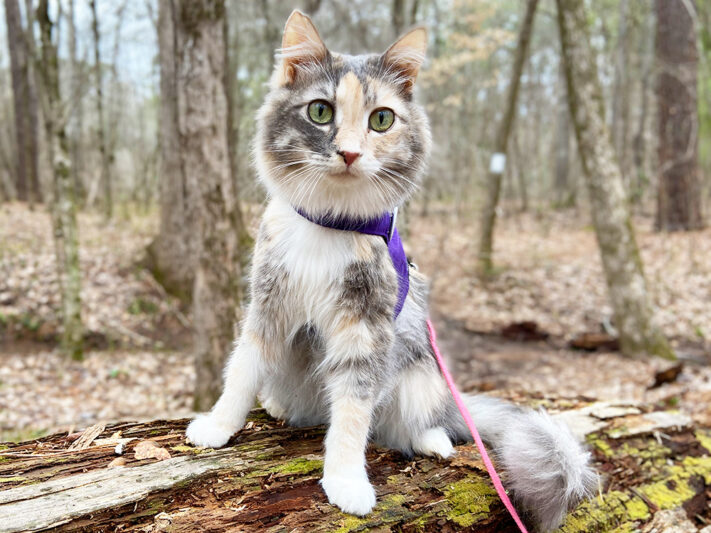
7. Cats with CH can live full and happy lives.
Oftentimes people’s first reaction when they see a cat with cerebellar hypoplasia is to feel sorry for them or think they couldn’t possibly have a good quality of life. These misconceptions couldn’t be further from the truth. As mentioned before, animals with CH are born the way they are and don’t know any differently. As long as they are well taken care of like any other pet, they can live full and happy lives.
8. CH Cats have valuable life lessons to teach us.
I have shared my heart and home with Sophie, my CH kitty, for roughly 12 years now. She amazes me on a daily basis and has taught me several valuable life lessons over the years, including:
When you fall, get back up and try again. Whenever Sophie falls over, she always gets right back up, shakes it off, and tries again with even more determination and enthusiasm than before. If she can handle her “failures” with such grace, then so can I!
Dream big. You can do anything! Over the years, Sophie has learned to climb the stairs, jump up on the furniture, and even get up on our cat tree – physical feats she couldn’t always accomplish. Don’t give up on your dreams! If it doesn’t happen today, it could happen tomorrow!
Embrace each other’s differences. The world is full of people from different backgrounds, who speak different languages, who have varying physical appearances, who think and believe in different ways. These differences are what make each person special or unique.
Every now and then my husband and I joke about what Sophie would be like if she wasn’t wobbly, and we always come to the same conclusion: She wouldn’t be the same. The thing that makes her different is the thing that enhances her personality.
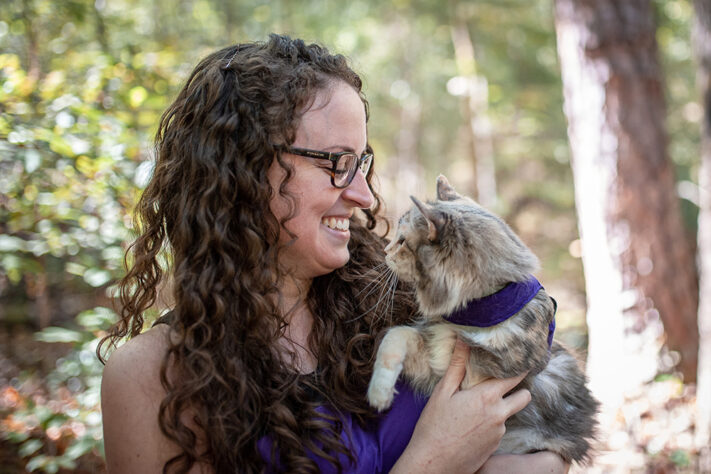
Be happy with who you are. Self-acceptance seems to be something we all struggle with at some point in our lives. We put ourselves down for our perceived flaws and are worried about what other people think. You know who doesn’t worry about those kinds of things? Sophie. She never seems to be bothered by her “flaws.” She just lives life to the fullest, perfectly happy with who she is.
Love unconditionally. Unconditional love is a trait that most animals seem to possess, but I think CH cats (and really all special-needs cats) have an extra helping of it. Maybe it’s because they usually have to rely on others for help, or maybe it’s because they struggle more with mundane things than most. Whatever it is, when I look into Sophie’s eyes, all I see is love. She loves hard and with her whole heart. She also happens to be the happiest creature I’ve ever known. Coincidence? I think not.
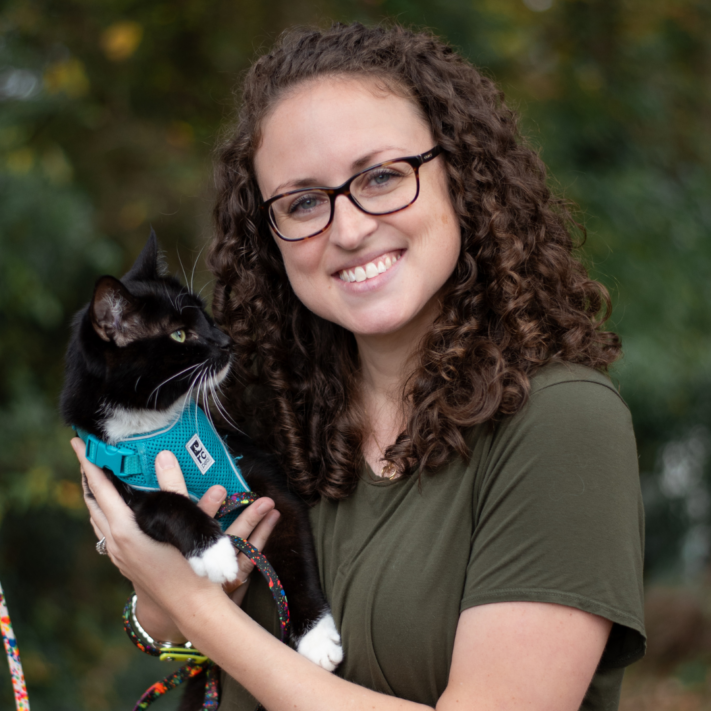
About the Author
Emily Hall, ABCCT is a certified cat trainer and cat adventure enthusiast. As a “mom” to six cats and one dog, she has been writing in the pet industry for 10 years, with a focus on traveling and adventuring with cats. Emily has a passion for getting out there and doing more with her cats – for pushing the bounds of cat expectations! She and her husband enjoy hiking, road-tripping, camping, and canoeing with their three cat adventurers. Read more about Emily here.
I have three of these wobble kitties. Emmy loves traveling! She goes to every conference that I attend. The other girls love car rides and going to outreach events for our cat rescue. 🙂
Great article about Sophie and cats with CH.
I first met Sophie at BlogPaws several years ago. Her dad had her in the vast lobby in harness and leash. I wanted to chat with him, but the only way I could do that was to walk along with him, very fast, as Sophie led us around the room. I loved her at first contact and subsequently put a “wobbly cat” in one of my cozy mystery series.
We thought precious little Bojack had wobbly cat syndrome but when we first got him he was fine then after about a month he started walking to the left but now he can hardly move his back legs at all. We’ve been to vets 3 times not the vet thinks we should have an mri. We will definitely anything for our baby but we took him within the first 2 weeks off insuring him so now we have to pay for all treatments 😢
So we will save up hard but it’s nearly £3000 just for the mri and consultation, god knows how long it will take to get the money together. Then save up again for any treatments. He is only 5 months old and it’s heartbreaking watching him. Reading your article makes me believe it isn’t CH as it has gotten worse over this last month. 😣
Lots of cat cuddles from Bojack and Mandy
HOw precious these animals are. I love your kindness and your story, to 12 more wonderful years.